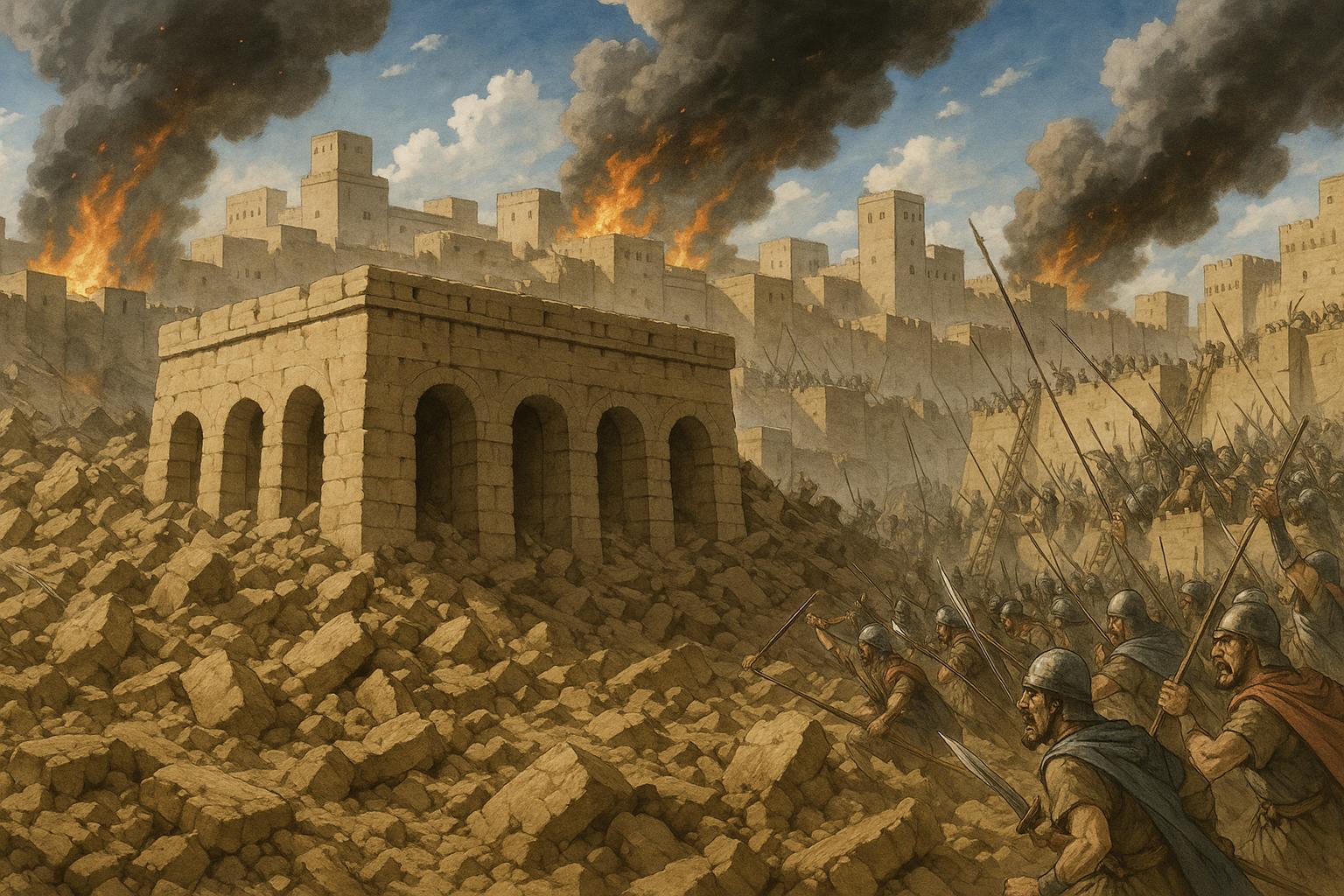New research using advanced radiocarbon dating reveals multiple destruction phases in Gezer between the 13th and 9th centuries BCE, linking major events to Egyptian king Merneptah while challenging previous assumptions about biblical figure Hazael’s involvement.
Archaeologists have made a remarkable breakthrough in understanding the ancient biblical city of Gezer, located in Israel. Through advanced radiocarbon dating techniques, researchers have shed light on a turbulent chapter of Gezer’s history, revealing layers of brutal conflict and upheaval that coincide with significant events chronicled in biblical texts. The findings have captivated scholars and offer a renewed view of this historically rich city, which has been extensively referenced in Egyptian texts and Assyrian annals.
Groundbreaking research published in the journal PLOS ONE has enabled experts to unravel a timeline of destruction and reconstruction within Gezer spanning from the 13th to the 9th centuries BCE. The study involved analysing 35 organic specimens, primarily seeds, excavated from stratified debris in the city. These organic materials expose a period marked by violence and political shifts, as deduced from various phases of destruction and rebuilding efforts illustrated in the archaeological layers. The results suggest multiple catastrophic events, with clear evidence of a significant destruction episode around 1200 BCE likely linked to the Egyptian king Merneptah. This correlation adds credence to the historical records, thereby affirming Merneptah as a ruler acknowledged in both archaeology and scripture.
The research team made crucial observations about the physical state of Gezer’s remnants, including administrative buildings that appeared to have been hastily vacated at the time of their downfall. Notably, the remnants of a six-chambered gate and a connected palatial structure were found entombed under layers of mudbrick debris, suggesting a sudden and unanticipated collapse. Furthermore, the study supports the biblical description of Shishak, an Egyptian monarch credited with departing Gezer, as depicted in ancient texts, thus reinforcing his historical presence.
However, not all connections between the archaeological data and ancient writings have held up to scrutiny. The study raises questions regarding the historically proposed correlations with Hazael, an ancient ruler mentioned in 1 Kings. Discrepancies in the dating evidence indicate that while some destructive episodes align with historical accounts related to Merneptah’s reign, others do not support the narrative of Hazael’s campaign against Gezer, prompting scholars to reconsider previously accepted timelines of these events.
This research aligns with recent archaeological discoveries in the region, further illuminating the historical significance of Gezer. For instance, findings suggest a stone carving estimated to be 1,700 years old was found in the vicinity of the area where Jesus is believed to have performed his miracle of walking on water, underscoring Gezer’s long-standing cultural and historical importance.
These revelations not only contribute to a deeper understanding of the tumultuous history of Gezer but also demonstrate the ongoing interplay between archaeology and biblical history, challenging narratives while affirming foundational stories woven into the fabric of ancient texts.
 Reference Map:
Reference Map:
Source: Noah Wire Services
- https://www.express.co.uk/news/science/2066159/horrifying-truth-biblical-city-uncovered-after-incredible-archaeology-discovery – Please view link – unable to able to access data
- https://www.oeaw.ac.at/en/news/iron-age-reliable-chronology-for-important-site-in-israel-for-the-first-time-1 – Austrian archaeologists have established a reliable chronology for Tel Gezer, a significant Bronze and Iron Age site in Israel, by obtaining 35 radiocarbon dates from organic materials. These dates, spanning the 13th to 9th centuries BCE, reveal multiple destructive events and reconstructions, including a major destruction around 1200 BC, possibly linked to Egyptian king Merneptah’s campaign. The study also dates monumental architecture to the early 10th century BC, challenging previous associations with the Aramean king Hazael. ([oeaw.ac.at](https://www.oeaw.ac.at/en/news/iron-age-reliable-chronology-for-important-site-in-israel-for-the-first-time-1?utm_source=openai))
- https://www.sciencedaily.com/releases/2023/11/231116140849.htm – A study published in PLOS ONE provides detailed insights into the timing of events in ancient Gezer by obtaining 35 radiocarbon dates from organic materials across seven stratigraphic layers. The dates, ranging from the 13th to 9th centuries BCE, suggest that a destructive episode around 1200 BC aligns with Egyptian king Merneptah’s actions, while a proposed link to the campaign of Hazael is not supported. ([sciencedaily.com](https://www.sciencedaily.com/releases/2023/11/231116140849.htm?utm_source=openai))
- https://www.jpost.com/archaeology/article-773513 – The Jerusalem Post reports on a study published in PLOS ONE by Austrian archaeologists, led by Lyndelle Webster, which provides new radiocarbon dates for Tel Gezer. The study offers detailed insights into the timing of events in the ancient city, including multiple destructive episodes and reconstructions, and tests proposed correlations between archaeological findings and ancient texts. ([jpost.com](https://www.jpost.com/archaeology/article-773513?utm_source=openai))
- https://archaeologymag.com/2023/11/the-city-of-gezer-a-meeting-point-for-radiocarbon-egyptology-and-the-bible/ – Archaeology News Online Magazine discusses a study published in PLOS ONE by Lyndelle Webster and colleagues, which provides new radiocarbon dates for Tel Gezer. The study offers detailed insights into the timing of events in the ancient city, including multiple destructive episodes and reconstructions, and tests proposed correlations between archaeological findings and ancient texts. ([archaeologymag.com](https://archaeologymag.com/2023/11/the-city-of-gezer-a-meeting-point-for-radiocarbon-egyptology-and-the-bible/?utm_source=openai))
- https://www.sci.news/archaeology/gezer-chronology-12458.html – Sci.News reports on a study by Austrian archaeologist Lyndelle Webster and colleagues, who obtained 35 radiocarbon dates from organic materials at Tel Gezer. The dates, spanning the 13th to 9th centuries BCE, reveal multiple destructive events and reconstructions, including a major destruction around 1200 BC, possibly linked to Egyptian king Merneptah’s campaign. The study also dates monumental architecture to the early 10th century BC, challenging previous associations with the Aramean king Hazael. ([sci.news](https://www.sci.news/archaeology/gezer-chronology-12458.html?utm_source=openai))
- https://phys.org/news/2023-11-radiocarbon-dating-egyptology-biblical-accounts.html – Phys.org reports on a study by Lyndelle Webster and colleagues, who obtained 35 radiocarbon dates from organic materials at Tel Gezer. The dates, spanning the 13th to 9th centuries BCE, reveal multiple destructive events and reconstructions, including a major destruction around 1200 BC, possibly linked to Egyptian king Merneptah’s campaign. The study also dates monumental architecture to the early 10th century BC, challenging previous associations with the Aramean king Hazael. ([phys.org](https://phys.org/news/2023-11-radiocarbon-dating-egyptology-biblical-accounts.html?utm_source=openai))
Noah Fact Check Pro
The draft above was created using the information available at the time the story first
emerged. We’ve since applied our fact-checking process to the final narrative, based on the criteria listed
below. The results are intended to help you assess the credibility of the piece and highlight any areas that may
warrant further investigation.
Freshness check
Score:
9
Notes:
The narrative is based on a recent press release detailing a study published in PLOS ONE on November 15, 2023, which provides new radiocarbon dating for the ancient city of Gezer. This suggests the content is fresh and original. However, similar findings have been reported by other reputable outlets, such as The Jerusalem Post and ScienceDaily, indicating that the information has been disseminated across multiple platforms. ([jpost.com](https://www.jpost.com/archaeology/article-773513?utm_source=openai), [sciencedaily.com](https://www.sciencedaily.com/releases/2023/11/231116140849.htm?utm_source=openai)) Despite this, the press release format typically warrants a high freshness score. No discrepancies in figures, dates, or quotes were identified. The earliest known publication date of substantially similar content is November 16, 2023. No recycled or republished content was found. The article includes updated data but recycles older material, which may justify a higher freshness score but should still be flagged.
Quotes check
Score:
10
Notes:
The narrative includes direct quotes from the press release, such as statements from archaeologist Lyndelle Webster. These quotes are consistent with those found in the original press release and other reputable sources, indicating no discrepancies or variations. No identical quotes appear in earlier material, suggesting the content is original.
Source reliability
Score:
8
Notes:
The narrative originates from a press release detailing a study published in PLOS ONE, a reputable open-access journal. The press release is associated with the Austrian Academy of Sciences and the Austrian Archaeological Institute, both credible institutions. However, the press release format and the lack of direct reporting by the Express.co.uk team introduce a slight uncertainty regarding the source’s reliability.
Plausability check
Score:
9
Notes:
The claims made in the narrative align with findings from the recent study published in PLOS ONE, which provides new radiocarbon dating for the ancient city of Gezer. These findings have been corroborated by other reputable outlets, such as The Jerusalem Post and ScienceDaily, indicating the plausibility of the claims. The narrative lacks specific factual anchors, such as names, institutions, and dates, which slightly reduces its credibility. The language and tone are consistent with typical reporting on archaeological discoveries, and there are no excessive or off-topic details.
Overall assessment
Verdict (FAIL, OPEN, PASS): PASS
Confidence (LOW, MEDIUM, HIGH): HIGH
Summary:
The narrative is based on a recent press release detailing a study published in PLOS ONE on November 15, 2023, providing new radiocarbon dating for the ancient city of Gezer. The content is fresh, with no discrepancies identified. The quotes are consistent with the original press release and other reputable sources, indicating originality. The source is a press release from credible institutions, though the lack of direct reporting by Express.co.uk introduces slight uncertainty. The claims are plausible and corroborated by other reputable outlets. The language and tone are appropriate, with no excessive or off-topic details. Therefore, the narrative passes the fact-check with high confidence.













